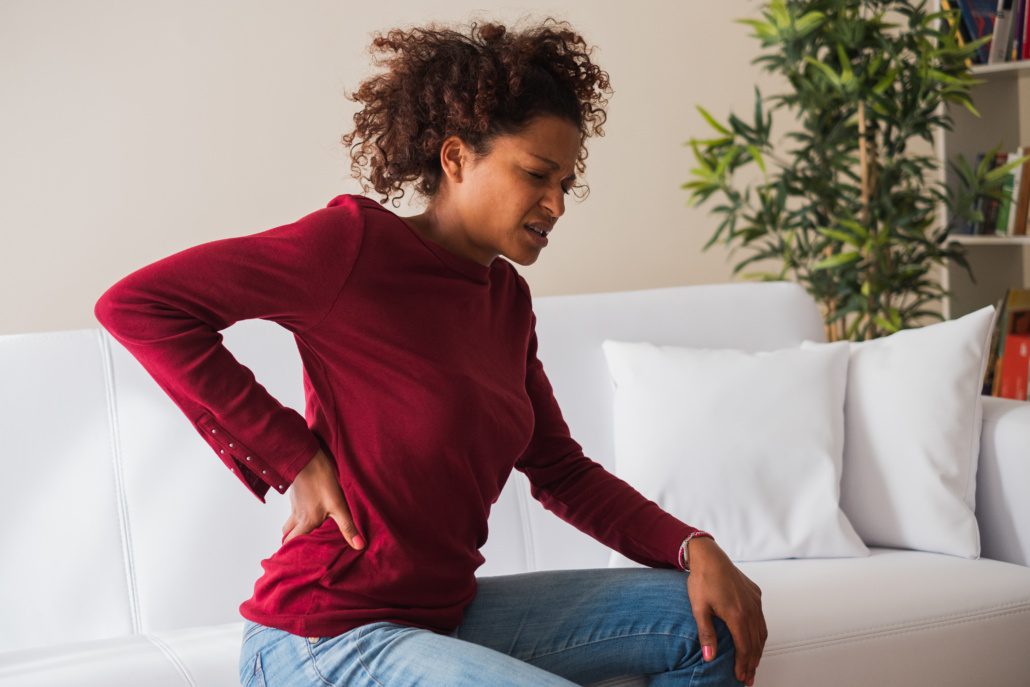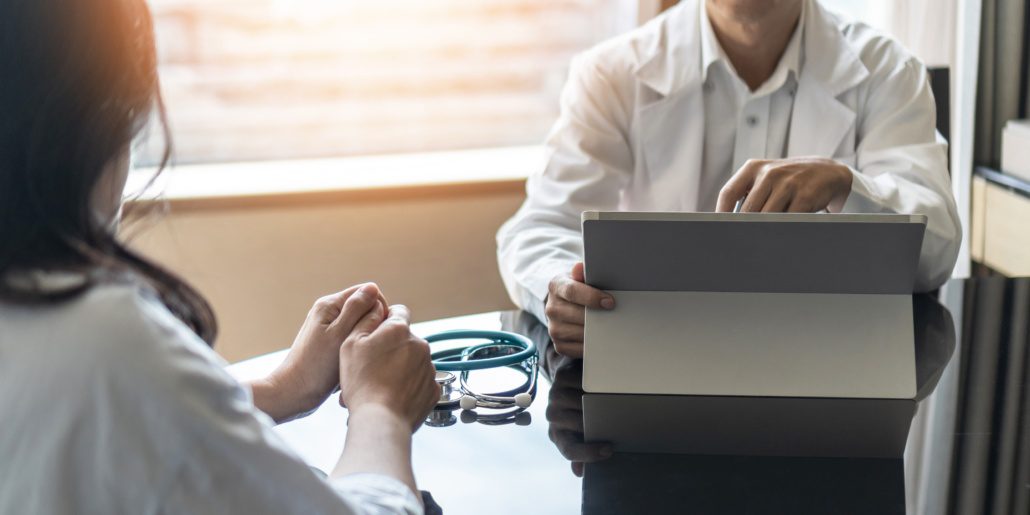Rectovaginal Endometriosis – Endometriosis Involving the Intestines
Rectovaginal endometriosis is categorized within the group of deep infiltrating endometriosis (DIE). This term refers to endometriosis lesions established between the vagina and the bowel. When endometriosis extends into organs or structures, encompassing the tissue between the bowel and vagina, it is termed as deep infiltrating endometriosis.
If these lesions breach the outer bowel wall, essentially growing into the bowel wall itself, it is referred to as deep infiltrating endometriosis with bowel involvement. This condition is found in approximately 25% of all endometriosis patients [5]. Endometriosis affecting the rectovaginal septum may manifest with or without intestinal infiltration. Both variations can impact a patient’s fertility or overall quality of life. Individuals afflicted with this condition frequently report experiencing intense discomfort, notably during sexual intercourse (dyspareunia) and bowel movements (dyschezia) [5]. The scope of treatment and therapy depends on the extent of the condition and necessitates the expertise of specialized surgeons and urologists, who collaborate with gynecologists to surgically remove the problematic tissue.
Symptoms of Rectovaginal Endometriosis
In addition to the classic indicators of endometriosis, rectovaginal endometriosis frequently presents with other symptoms, including infertility and intense pain both during and outside of menstruation [2].
The following manifestations may arise:
- Pain and challenges during bowel movements (dyschezia).
- Pain during sexual intercourse (dyspareunia), often leading to reduced libido due to the severity of pain.
- Swollen abdomen – referred to as “endo-belly”, this symptom can also manifest in other forms of endometriosis and result in severe discomfort.
- Rectal bleeding synchronized with the menstrual cycle.
- Severe abdominal pain.
- Nausea.
- Lower back pain, particularly in the lumbar region.
- Disturbances in bowel movements such as diarrhea and constipation.
- In rare instances, intestinal obstruction might occur.
Diagnosis
Given the diverse array of symptoms associated with endometriosis, diagnosing intestinal endometriosis poses challenges.
Initially, a preliminary diagnosis can be established by observing symptoms and gauging pain levels using a pain scale.
Particularly in rectovaginal endometriosis cases, the rectovaginal palpation method plays a pivotal role in diagnosis. Here a physician palpates the vagina and rectum using one finger each, facilitating a comprehensive assessment of the intervening area where rectovaginal endometriosis occurs. Skilled examiners can identify strong indicators of rectovaginal endometriosis through this approach.
Ultrasound can also prove useful in the diagnostic process. The assessment begins with an examination of the uterus and ovaries. Subsequently, the mobility of the ovaries and the “sliding sign” – which gauges uterus mobility – are evaluated. The presence of rectovaginal adhesions can limit mobility, a condition that can be directly assessed through ultrasound. Further steps involve assessing involvement in the posterior and anterior compartments, the bladder, and the intestines [5]. Additionally, rectal endosonography can yield informative insights.
Depending on the findings, an MRI can supply supplementary insights into the extent of endometriosis adhesions. Particularly, when assessing potential penetration of the bowel wall, MRI can offer valuable information for guiding interventions like bowel resection before surgical procedures [3]. However, a negative result from an MRI does not definitively exclude the presence of rectovaginal endometriosis.
Occasionally, a colonoscopy is also conducted. Nevertheless, as endometriosis typically grows from the exterior of the bowel inward, an unremarkable colonoscopy does not definitively rule out bowel endometriosis as a possibility.
For precise information about the location and whether rectovaginal endometriosis exists solely on the bowel’s outer wall or has breached it, surgical intervention via laparoscopy is imperative [3]. In some instances, lesions might not be visible on ultrasound and endosonography, and the complete extent of endometriosis might only become apparent during laparoscopy. Consequently, decisions regarding potential bowel resection are often made during the actual surgery [3]. As such, discussions about the approach in cases of potential bowel involvement should be part of pre-operative consultations to establish a contingency plan with the surgeon.
Treatment
The treatment and therapy approach for endometriosis with bowel involvement necessitates consideration of various factors [5]:
- Patient’s Age
- Desire for Pregnancy
- Extent of Endometriosis
- Impact on Adjacent Organs
- Symptoms and Pain
In cases where rectal endometriosis is incidentally discovered without symptoms, surgical intervention may not be imperative as per guidelines. However, typically, rectovaginal endometriosis is linked with problems and pain.
Given the involvement of multiple organs, including the intestines, specialized treatment is recommended, often conducted in centers equipped to collaborate with specialized departments such as intestinal surgeons.
Surgery often becomes necessary, especially for rectovaginal endometriosis causing significant pain. While medication can alleviate pain, it does not eliminate the endometriosis itself. Hormone preparations, commonly used for other forms of endometriosis, can also be administered – these include progestins, combined pills, GnRH agonists/antagonists, or levonorgestrel-releasing IUD [5]. Small-scale studies have shown symptom improvement through vaginal hormone rings, making this an individual option worth considering.
For symptomatic endometriosis with bowel involvement, surgical removal of the endometriosis lesions frequently emerges as the preferred approach. This surgery stands as the optimal choice for long-term pain relief and improved fertility [4].
However, these decisions should be tailored to each patient and discussed with the appropriate medical center.
Particularly when deep-infiltrating endometriosis affects the bowel wall, bowel resection might be considered. Surgical procedures involving organs like the bladder, ureters, and bowel requires a well-trained, experienced team of gynecologists, surgeons, and urologists to ensure the procedure is performed with minimal damage, allowing the patient to awaken from anesthesia with the least possible impact.
Good to know!
Before any surgical procedure, and especially when the bowel is involved, thorough discussions about “if-then” scenarios are imperative. The true extent of the endometriosis often only becomes evident during the operation, by which time the patient is already under anesthesia. This underscores the importance of addressing potential scenarios during every consultation, particularly when the intestine is affected. Operations involving the intestine, which might include the removal of a segment of the intestine, carry inherent risks. It is crucial to highlight that based on the surgeon’s evaluation, a temporary artificial anus could be created. This can be later reversed after a certain period, meaning it is not a permanent arrangement. However, because this decision impacts the post-operative period, it’s vital to have a comprehensive discussion with your doctor. If endometriosis affects the intestine, an essential choice arises: should the operation proceed directly to remove all affected areas, or should a second operation be planned to allow for a more detailed discussion of the extent and associated risks? This decision is deeply individual, prompting the need to be thoroughly informed and contemplate different outcomes ahead of time.
Post-Operative Considerations:
If the bowel wall has not been breached and the endometriosis has been successfully removed from the outer bowel wall, bowel resection might not be necessary. In cases where a segment of the bowel was excised, the placement of an artificial bowel outlet could be an option for several weeks or months, prompting healing in the operated areas.
Bowel resection often enhances fertility for many patients. Research indicates that 44.6% of women with childbearing potential were able to conceive after undergoing bowel resection for deep infiltrating bowel endometriosis. Moreover, laparoscopic colorectal resection for endometriosis is associated with the alleviation of symptoms and notable improvements in overall quality of life [1]. Just as before surgery, patients received tailored counseling about potential drug therapies, including progestins. Furthermore, a diet optimized for endometriosis management is recommended.
References
- Daraï E, Bazot M, Rouzier R, Houry S, Dubernard G. Outcome of laparoscopic colorectal resection for endometriosis. Curr Opin Obstet Gynecol. 2007 Aug;19(4):308-13. doi: 10.1097/GCO.0b013e328216f6bc. PMID: 17625410.
- Donnez J, Nisolle M, Gillerot S, Smets M, Bassil S, Casanas-Roux F. Rectovaginal septal adenomyotic nodules: a series of 500 cases. Br J Obstet Gynaecol. 1997 Sep;104(9):1014-8. doi: 10.1111/j.1471-0528.1997.tb12059.x. PMID: 9307527.
- Mangler, M, Medrano, N, Lanowska M, Bartley, J, Schneider, A, Köhler, C. Preoperative diagnosis of bowel involvement in rectovaginal endometriosis. in Obstetrics Gynecology 2007; 67 – A30.
- Mangler, M., Loddenkemper, C., Lanowska, M., Bartley, J., Schneider, A., Köhler, C. A combined surgical approach to the therapy of rectovaginal endometriosis based on histological findings. Journal of Gynecologic Endocrinology 2008; 2 (2) (issue for Austria). Gablitz.
- Tiringer, D, Husslein, H, Küssel, L, Wenzl, R. Diagnosis and therapy of “rectovaginal” or deep infiltrating “intestinal” endometriosis. 37th ed. 1/2019.
- “Take yourself and your endometriosis seriously. You are not imagining things!” - 7. November 2023
- Interview with Endometriosis Patient Nina - 7. November 2023
- Interview with Endometriosis Patient Nina - 7. November 2023



